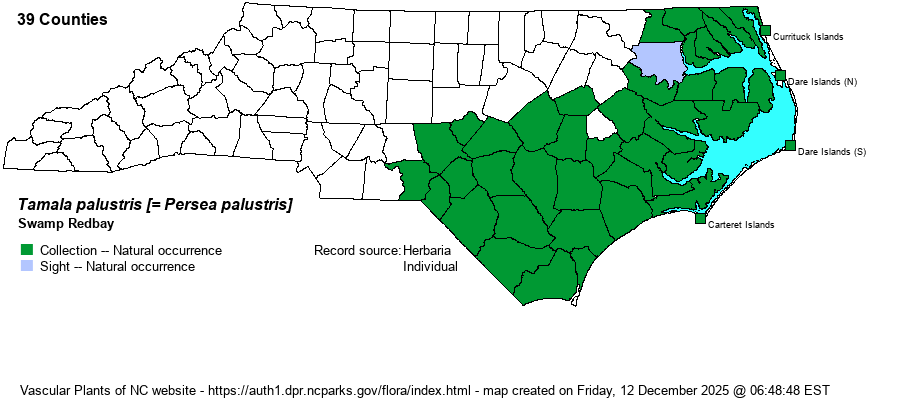| Author | Rafinesque | |
| Distribution | Nearly throughout the Coastal Plain, except apparently absent in the extreme northwestern corner (Halifax, Northampton, and a few neighboring counties). Not recorded from the Piedmont.
This species is found over nearly all counties within its range, from DE south to southern FL and west to eastern TX. It essentially does not range into Piedmont counties.
| |
| Abundance | Common to very common across nearly all of its NC range. Very widespread in a great variety of wet to mesic forested habitats. Though large numbers of this species have been killed by laurel wilt disease from FL north to SC and sparingly into southeastern NC, it still remains very numerous in the state, at least for the time being. | |
| Habitat | This is a dominant species of pocosins and bay forests, Sandhills streamheads, swamps, and other damp to wet and peaty soils. It does grow in maritime forests with P. borbonia and thus the habitats of the two overlap there. It is essentially impossible to miss finding this species in a day of field work in most Coastal Plain counties. |
| Phenology | Blooms in May and June, and fruits in September and October. | |
| Identification | This is a rather small to often medium evergreen tree, growing to about 50 feet tall. The alternate and leathery, entire leaves often contain leaf galls and other imperfections from caterpillar damage, etc. The narrowly elliptic leaves grow to about 4-4.5 inches long and are somewhat rusty colored below, at least on the veins. The twigs also tend to be hairy/rusty, as well. In fall, this species is often heavily adorned with dark blue to black drupes, making it easy to separate from several other bay species (Gordonia lasianthus, Magnolia virginiana). Also, Gordonia leaves are heavily scalloped on the margin, and the Magnolia has essentially white leaf undersides. Also, the dark “berries”, heavily chewed/impacted leaves, and fragrant scent of broken twigs will let the beginner know he/she has a Tamala and not one of the other two bay tree species. Care must be taken to rule out the very similar Upland Redbay (T. borbonia), a relatively rare tree in the state’s coastal region. See that species account for differences. | |
| Taxonomic Comments | A paper in 2020 by Song et al. has moved the Persea species to the genus Tamala, which is followed by Weakley (2022). Though there are no issues with this being a good species, until fairly recently it was lumped within the closely related P. borbonia, this being the oldest name. Older references often named this entire species as P. borbonia, as in RAB (1968).
| |
| Other Common Name(s) | Swamp Bay, Redbay. Most websites and references now name this species as Swamp Bay or Swampbay, and T. borbonia now as Red Bay. However, as the genus Tamala is typically called “Redbay”, the use of that word is confusing and hereby discouraged. It seems best thus to use “Redbay” in the common name for both, with a modifier name for each species. | |
| State Rank | S5 | |
| Global Rank | G5 | |
| State Status | | |
| US Status | | |
| USACE-agcp | | |
| USACE-emp | | |

